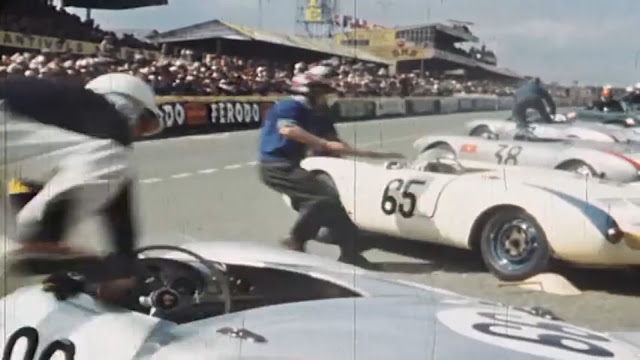LeMans 24 & HyperCar : Auto Race Motorsports in the Earth 4
YouTube
[ LeMans 24 & HyperCar
: Auto Race Motorsports in the Earth 4 ]
1. Le Mans 24-hour crisis
The “FIA World Endurance Championship” began in 2012 and continues to this day.Called WEC for short, the competition includes 24 hours of Le Mans.
By the way, the crisis came to the 'Le Mans 24 Hours' race, which will have a 100-year history in 2023.
That is, since 2018, Toyota is the only factory team that participates in the ‘LMP1 class’, the top class of Le Mans 24 hours, where sports prototypes compete, and other car manufacturers are no longer participating.
Automotive technology is developing rapidly from the internal combustion engine era of gasoline and diesel through hybrids to the electric vehicle era.
In line with this trend, Le Mans LMP1 class sports prototype racecars are now using hybrid power systems via gasoline engines and diesel engines.
However, most manufacturers thought that hybrid vehicles would disappear when the battery-related technology and charging infrastructure needed for electric vehicles were equipped, and they would only be a bridge between internal combustion engine cars and electric vehicles.
Almost every manufacturer's consensus was that the future of cars would not be hybrid cars, but electric vehicles(EV) or fuel cell electric vehicles(FCEV).
As a result, automakers began focusing their investments on electric vehicle technology rather than hybrid technology.
So, automakers naturally left the Le Mans 24 hour race and the WEC competition, where hybrid sports prototypes participated and moved to electric car racing like Formula E.
2. Le Mans 24 & Electric Vehicle (EV)
Even in Le Mans 24 hours, it was an issue that could be solved by using an electric car as a race car like Formula E.However, in the endurance races such as Le Mans 24 hours, where the race runs for 24 hours compared to the sprint race that lasts about 2 hours, the single-charging mileage and the charging time of the electric vehicle caught the ankle.
The current level of electric vehicle technology is no matter how fast the battery can be charged, it is possible to drive around 62mile(100km) for 5 minutes charging and 250mile(400km) for 15 minutes charging.
In addition, although investment and research are focused on the development of battery capacity and charging technology, it is not developing as fast as people expect.
In Le Mans 24 hours, race cars run more than 3,107mile(5,000km) in 24 hours.
If an electric car is used as a race car, at least 3 hours out of 24 hours should be used as charging time.
In a race where 0.01 seconds is important, it was impossible to pit in periodically to charge for tens of minutes.
It was also discussed how to charge two cars alternately, or how to replace a used battery with a fully charged battery.
But in Le Mans 24 hours, where not only speed but also durability are competing, the continued replacement of the core components of the powertrain was not a way for the purpose of the endurance race.
3. Le Mans 24 & Hydrogen Fuel Cell Electric Vehicle (FCEV)
Thus, an electric car but a fast charging hydrogen fuel cell electric vehicles(FCEV) was discussed as a race car.Fuel cell electric vehicle seemed to be a race car of the Le Mans 24 Hours because it had no battery charging problems.
However, manufacturers have different ideas about which electric vehicle or fuel cell electric vehicle will become the trend of the future.
Since more manufacturers were focusing on developing electric vehicles rather than fuel cell electric vehicles, even using a fuel cell electric vehicle as a race car seemed difficult to turn the steps of manufacturers who left Le Mans 24 hours.
Thus, the direction of the Le Mans 24 hour race was to be found in another flow, not an electric vehicle or a fuel cell electric vehicle.
4. Le Mans 24 & Hypercar
In response to human desires for higher performance super sports cars, automakers had to increase the performance of super sports cars.Due to increased environmental regulations, by the early 2010s, it was almost impossible to increase the output while satisfying the emission regulations with the internal combustion engine.
So hybrid technology was incorporated into the development of super sports cars.
As a result, the company has developed cars capable of nearly 1,000 horsepower, called hypercars, beyond the super sports car.
In the late 2010s, in order to further enhance the performance of hypercars, the company began developing hypercars equipped with the world's most powerful car engine like the F1 race car engine or the hybrid engine of the Le Mans 24 hour sports prototype.
Le Mans 24 hours was interested in hypercars with race car technology
Instead of the traditional way of developing sports prototypes for races, If the hypercar, which is already developed for mass production, is converted to a race car, the cost of the race can be reduced by a quarter(25%) of what it was.
Many manufacturers were expected to return to Le Mans 24 hours if hypercars can significantly reduce the burden on the development and cost of racing.
So it was evaluated as a way for each other to win-win.
As such, the WEC competition, which includes the Le Mans 24 hour race, is preparing to introduce the “Hyper Car Class” Since the 2020 season.
Toyota has confirmed its participation in the hypercar class,
Lamborghini,
Aston Martin,
Mercedes-Benz and many other carmakers are interested and are actively considering participating in Le Mans 24 hours.
As the electric car era approached, Le Mans 24 Hours faced a crisis
but finally found a solution and could write 100 years of history.
CARirang Talk 5-2




























































